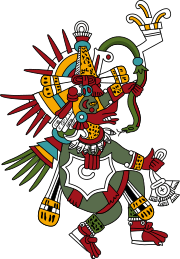Tepoztecatl

In Aztec mythology, Tepoztecatl [teposˈteːkat͡ɬ] (from tepoztli "workable metal" [teˈpost͡ɬi] and tēcatl "person" [ˈteːkat͡ɬ] ) or Tezcatzontecatl [teːskat͡sonˈteːkat͡ɬ] (from tēzcatl [teːskat͡ɬ] "mirror", tzontli "four hundred" [ˈt͡sont͡ɬi] and tēcatl "person" [ˈteːkat͡ɬ]) was the god of pulque, of drunkenness and fertility. The deity was also known by his calendrical name, Ometochtli ("two-rabbit").[1] He is a consort of Mayahuel, who is a mask-avatar of Xochiquetzal.
According to Aztec myth, Tepoztecatl was one of the Centzon Totochtin,[2] the four hundred children of Mayahuel, the goddess of the maguey plant, and Patecatl, the god that discovered the fermentation process.[1] As a deity of pulque, Tepoztecatl was associated with fertility cults and Tlaloc.[1] Tepoztecatl was also associated with the wind, hence deriving an alternative name of Ehecacone, son of the wind.[1]
Tepoztecatl appears in the Mendoza Codex carrying a copper axe.[1]
El Tepozteco, in the Mexican state of Morelos, is an archaeological site named after the deity. The site was a sacred place for pilgrims from as far as Chiapas and Guatemala.[1] This site has a small pyramid built on a platform, with a combined height of 9.5 metres (31 ft), located on a mountain overlooking the town of Tepoztlan.[1]
See also
Notes
References
- Canto Aguilar, Giselle (1998). El Tepozteco, Morelos (Miniguía) (in Spanish). Mexico: Instituto Nacional de Antropología e Historia.
- Fernández, Adela (1996) [1992]. Dioses Prehispánicos de México (in Spanish). Mexico City: Panorama Editorial. ISBN 968-38-0306-7. OCLC 59601185.
